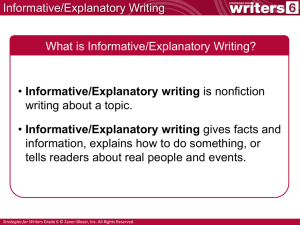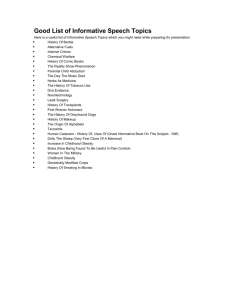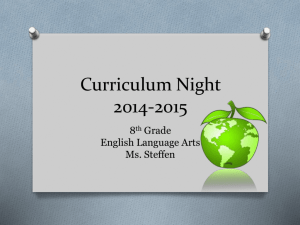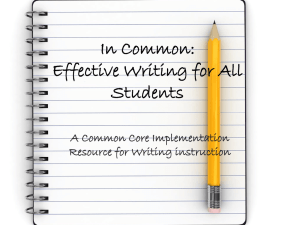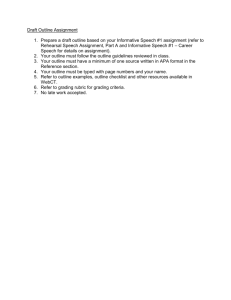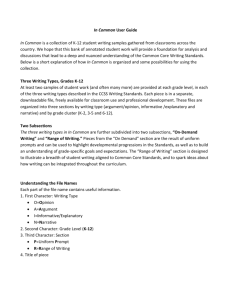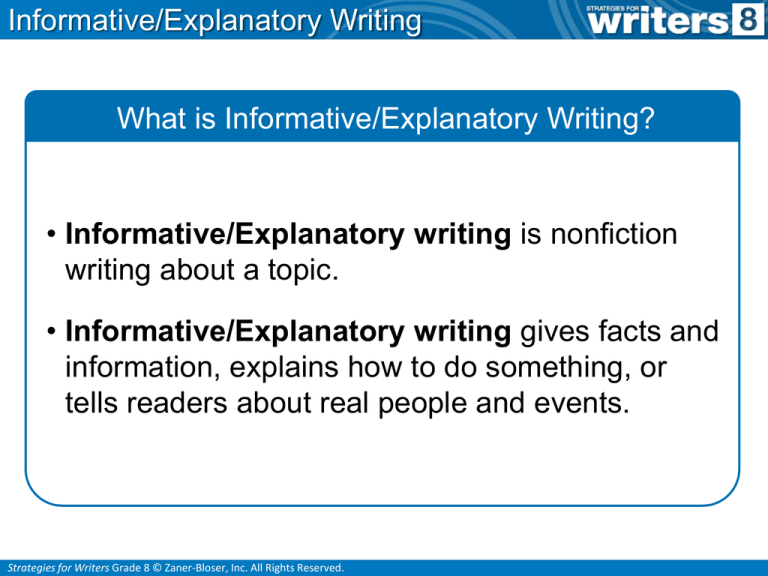
Informative/Explanatory Writing
What is Informative/Explanatory Writing?
• Informative/Explanatory writing is nonfiction
writing about a topic.
• Informative/Explanatory writing gives facts and
information, explains how to do something, or
tells readers about real people and events.
Strategies for Writers Grade 8 © Zaner-Bloser, Inc. All Rights Reserved.
Informative/Explanatory Writing
You can find informative/explanatory writing in
many different places.
• Textbooks
• Newspapers
• Encyclopedias
• Magazines
• Websites
Strategies for Writers Grade 8 © Zaner-Bloser, Inc. All Rights Reserved.
Informative/Explanatory Writing
Informative/Explanatory Writing Traits
• A clear, focused topic
• Relevant facts and concrete details that support and
develop the topic
• A strong introduction, body, and conclusion
• Paragraphs that have a topic sentence and supporting
details
• Appropriate and varied transitions that connect ideas
and show relationships
Strategies for Writers Grade 8 © Zaner-Bloser, Inc. All Rights Reserved.
Informative/Explanatory Writing
Informative/Explanatory Writing Traits
• Appropriate voice for the purpose and audience
• An informative, respectful, and consistent tone
• Exact, concise language
• Domain-specific vocabulary that is used correctly and
explained as necessary
• Clear sentences with structure that supports the purpose
• Sentences that flow together smoothly
• No or few errors in grammar, usage, and mechanics
Strategies for Writers Grade 8 © Zaner-Bloser, Inc. All Rights Reserved.
Informative/Explanatory Writing
How informative/explanatory writing is organized
depends on its purpose.
• Cause-and-Effect describes a cause and the result, or
effect, of that cause.
• Compare-and-Contrast describes the similarities and
differences between things.
• Explanatory gives the meaning of a topic.
• How-To tells readers how something happens or explains
a step-by-step process.
• Problem-and-Solution describes a problem and offers
one or more solutions.
• Research Report organizes information about a topic.
• Summary describes the main points of a piece of writing.
Strategies for Writers Grade 8 © Zaner-Bloser, Inc. All Rights Reserved.
Informative/Explanatory Writing
Good informative/explanatory writing includes
the following features:
• Topic
• Definitions
• Facts
• Transitions
Let’s look at how we can
use these features in
good informative/
explanatory writing.
• Precise language
• Domain-specific vocabulary
• Conclusion
Strategies for Writers Grade 8 © Zaner-Bloser, Inc. All Rights Reserved.
Informative/Explanatory Writing
Topic
A tsunami is a series of giant waves. Tsunamis are created by
undersea disturbances, such as earthquakes or giant landslides.
As the waves travel away from the point of the undersea
disturbance, they grow taller and gain higher speeds. However,
tsunami waves do not look like normal waves that curl and crash
against the beach. Instead, they look like a moving wall of water.
In order to understand tsunamis, it is important to understand
how Earth is formed. Tectonic plates, or giant pieces of Earth’s
crust, sometimes push against each other. At times this motion
can be subtle; other times it can be violent. An earthquake is
caused when two plates push and pull against each other and
suddenly release a tremendous amount of energy.
Strategies for Writers Grade 8 © Zaner-Bloser, Inc. All Rights Reserved.
Informative/Explanatory Writing
Definitions
A tsunami is a series of giant waves. Tsunamis are created by
undersea disturbances, such as earthquakes or giant landslides.
As the waves travel away from the point of the undersea
disturbance, they grow taller and gain higher speeds. However,
tsunami waves do not look like normal waves that curl and crash
against the beach. Instead, they look like a moving wall of water.
In order to understand tsunamis, it is important to understand
how Earth is formed. Tectonic plates, or giant pieces of Earth’s
crust, sometimes push against each other. At times this motion
can be subtle; other times it can be violent. An earthquake is
caused when two plates push and pull against each other and
suddenly release a tremendous amount of energy.
Strategies for Writers Grade 8 © Zaner-Bloser, Inc. All Rights Reserved.
Informative/Explanatory Writing
Facts
A tsunami is a series of giant waves. Tsunamis are created by
undersea disturbances, such as earthquakes or giant landslides.
As the waves travel away from the point of the undersea
disturbance, they grow taller and gain higher speeds. However,
tsunami waves do not look like normal waves that curl and crash
against the beach. Instead, they look like a moving wall of water.
In order to understand tsunamis, it is important to understand
how Earth is formed. Tectonic plates, or giant pieces of Earth’s
crust, sometimes push against each other. At times this motion
can be subtle; other times it can be violent. An earthquake is
caused when two plates push and pull against each other and
suddenly release a tremendous amount of energy.
Strategies for Writers Grade 8 © Zaner-Bloser, Inc. All Rights Reserved.
Informative/Explanatory Writing
Transitions
A tsunami is a series of giant waves. Tsunamis are created by
undersea disturbances, such as earthquakes or giant landslides.
As the waves travel away from the point of the undersea
disturbance, they grow taller and gain higher speeds. However,
tsunami waves do not look like normal waves that curl and crash
against the beach. Instead, they look like a moving wall of water.
In order to understand tsunamis, it is important to understand
how Earth is formed. Tectonic plates, or giant pieces of Earth’s
crust, sometimes push against each other. At times this motion
can be subtle; other times it can be violent. An earthquake is
caused when two plates push and pull against each other and
suddenly release a tremendous amount of energy.
Strategies for Writers Grade 8 © Zaner-Bloser, Inc. All Rights Reserved.
Informative/Explanatory Writing
Precise Language
A tsunami is a series of giant waves. Tsunamis are created by
undersea disturbances, such as earthquakes or giant landslides.
As the waves travel away from the point of the undersea
disturbance, they grow taller and gain higher speeds. However,
tsunami waves do not look like normal waves that curl and crash
against the beach. Instead, they look like a moving wall of water.
In order to understand tsunamis, it is important to understand
how Earth is formed. Tectonic plates, or giant pieces of Earth’s
crust, sometimes push against each other. At times this motion
can be subtle; other times it can be violent. An earthquake is
caused when two plates push and pull against each other and
suddenly release a tremendous amount of energy.
Strategies for Writers Grade 8 © Zaner-Bloser, Inc. All Rights Reserved.
Informative/Explanatory Writing
Domain-Specific Vocabulary
A tsunami is a series of giant waves. Tsunamis are created by
undersea disturbances, such as earthquakes or giant landslides.
As the waves travel away from the point of the undersea
disturbance, they grow taller and gain higher speeds. However,
tsunami waves do not look like normal waves that curl and crash
against the beach. Instead, they look like a moving wall of water.
In order to understand tsunamis, it is important to understand
how Earth is formed. Tectonic plates, or giant pieces of Earth’s
crust, sometimes push against each other. At times this motion
can be subtle; other times it can be violent. An earthquake is
caused when two plates push and pull against each other and
suddenly release a tremendous amount of energy.
Strategies for Writers Grade 8 © Zaner-Bloser, Inc. All Rights Reserved.
Informative/Explanatory Writing
Conclusion
It is impossible to stop a tsunami. However, early warning
systems and accurate weather forecasting equipment can warn
people of the danger. Special buoys floating in the ocean record
waves and send information to scientists on land. These
scientists can then warn people to get away from the shore and
head to higher ground. Sometimes an early warning can save
thousands of lives from the deadly force of a tsunami.
Strategies for Writers Grade 8 © Zaner-Bloser, Inc. All Rights Reserved.
Informative/Explanatory Writing
Some common types of informative/explanatory
writing include the following:
• Research Report
• Cause-Effect Report
• Problem-Solution Essay
• Response to Literature
• How-To Essay
• Compare-and-Contrast Essay
Strategies for Writers Grade 8 © Zaner-Bloser, Inc. All Rights Reserved.
Strategies for Writers Grade 8 © Zaner-Bloser, Inc. All Rights Reserved.

